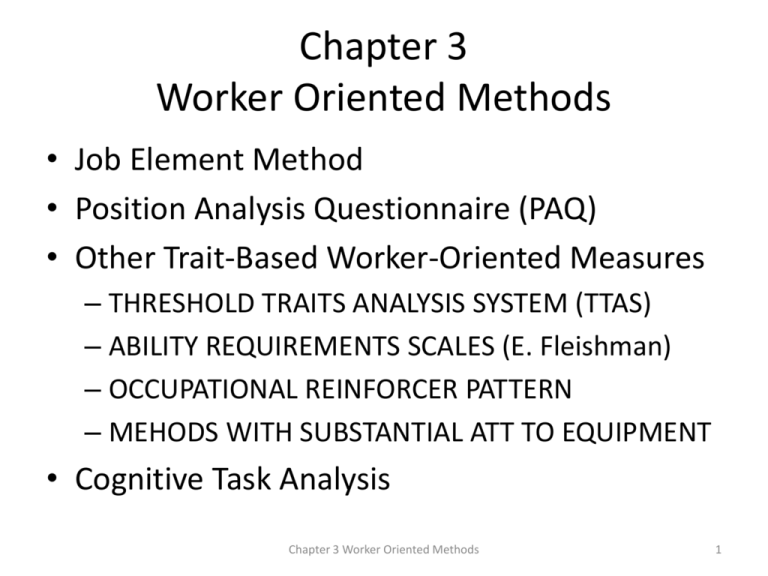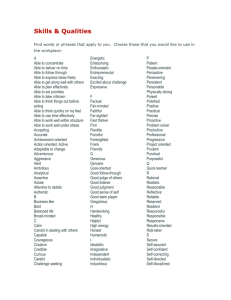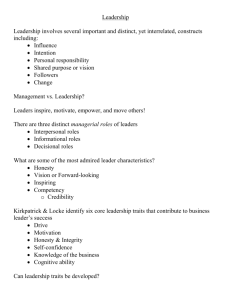Chapter 3 Worker Oriented Methods
advertisement

Chapter 3 Worker Oriented Methods • Job Element Method • Position Analysis Questionnaire (PAQ) • Other Trait-Based Worker-Oriented Measures – THRESHOLD TRAITS ANALYSIS SYSTEM (TTAS) – ABILITY REQUIREMENTS SCALES (E. Fleishman) – OCCUPATIONAL REINFORCER PATTERN – MEHODS WITH SUBSTANTIAL ATT TO EQUIPMENT • Cognitive Task Analysis Chapter 3 Worker Oriented Methods 1 Worker-Oriented Methods • Most “psychological” – Focus on KSAOs • Os = preferences, values, temperament, personality • Job Element – Blurs distinction between what gets done and abilities required to do it (elements not the same as FJA term) • • • PAQ – Well known in business...elements here means a finite list of things Other trait-based methods – TTAS has a comprehensive “global” list of traits Cognitive task analysis – Mental processes (where a lot of work is now and in the future) Chapter 3 Worker Oriented Methods 2 Job Element Method (E. Primoff, OPM) – – • CONTENT OF ELEMENTS – • Behaviors: Cognitive, psychomotor and work habits GATHERING INFORMATION – • Most similar to work oriented An element is combo of a behavior& evidence for it Requires experts RATING SCALES – SMEs rate on • • • • DERIVED SCALES – • 5 levels of importance RESEARCH ON JEM: THE J-COEFFICIENT – – • Based on previous scales (above) to get “total value”, “item index” (for test), “training value” ASSIGNING ELEMENTS TO CATEGORIES – • “barely acceptable” to “superior” “trouble likely if not considered” “practical” – to expect incumbent to have A ‘validity’ coefficient derived from human judgments Can be useful is anyone takes the time to use the method REMARKS ON JEM – An ability is whatever it takes to do it (circular reasoning) Chapter 3 Worker Oriented Methods 3 Position Analysis Questionnaire (E. McCormick) S-O-R theory – – Requires expert job analyst Elements apply to all jobs • • DEVLOPMENT AND STRUCTURE OF THE PAQ – 194 items (now 300) • • • Good for job evaluation and FLSA USES OF PAQ (objectives) – – Standardize an approach to ID worker requirements Job evaluation / disability considerations • • Better agreement with same job/ less between jobs Related to GATB mean scores (163 jobs) RESEARCH ON THE PAQ: COMMON KNOWLEDGE EFFECTS – – • Can this address any issues with your job? RELIABILITY AND VALIDITY – – • 187 for attributes; 7 for pay concerns Six major divisions (see table 3.4 p 74) PAQ RESULTS – • Why is this an advantage for job evaluation? Inter-rater reliability in ‘90s for different types of raters But the rater needs to be very familiar with the job itself RECENT PAQ DEVELOPMENTS – DOT http://www.paq.com Chapter 3 Worker Oriented Methods 4 Other Trait-Based Worker-Oriented Measures • THRESHOLD TRAITS ANALYSIS SYSLTEM (33 traits) – F. Lopez (‘70) • Theoretically coherent • Trait oriented • Multipurpose • Legally defensible • For selection / training / description/ evaluation • Two sections: 1. can do 2. will do Is this applicable to your job? • ABILITY REQUIREMENTS SCALES – E. Fleishman & Mumford • Generic human abilities • Abilities linked to tests for them • For selection and to build job families Is this applicable to your job? • OCCUPATIONAL REINFORCER PATTERN – – • Borgen, ‘88 Individual differences in what they need (e.g. recognition, working together / alone) METHODS WITH SUBSTANTIAL ATTENTION TO EQUIPMENT – – AET (ergonomics) Job Components Inventory (entry level jobs; vocational guidance; training) Chapter 3 Worker Oriented Methods 5 Cognitive Task Analysis – Cognitive psych: Mental activities must be inferred – Often difference (cognitive) ways to achieve the same outcome • TYPES OF KNOWLEDGE AND SKILL – Declarative vs. Procedural (what the difference?) – Generative knowledge (finding new relationships) – Self knowledge (know your limitations!) • K (acquired information) v. S (procedural) • Automated skills (fast and effortless) • Representational skills (mental models) • Decision making skills (Kahneman’s system I and system 2) – How experts complete their jobs Chapter 3 Worker Oriented Methods 6 • • • • COGNITIVE TASK ANALYSIS METHODS – Interviewing – Team communication – Diagramming – Verbal report – Psychological scaling A SIMPLE EXAMPLE – TSA screener (they are missing a lot these days) • the experienced ones develop a database of three dimensional rotated objects RELIABILITY AND VALIDITY –difficult to assess REMARKS ON COGNITIVE TASK ANALYSIS -Coming soon to a job near your What is a task in your job that requires cognitive task analysis? Chapter 3 Worker Oriented Methods 7






